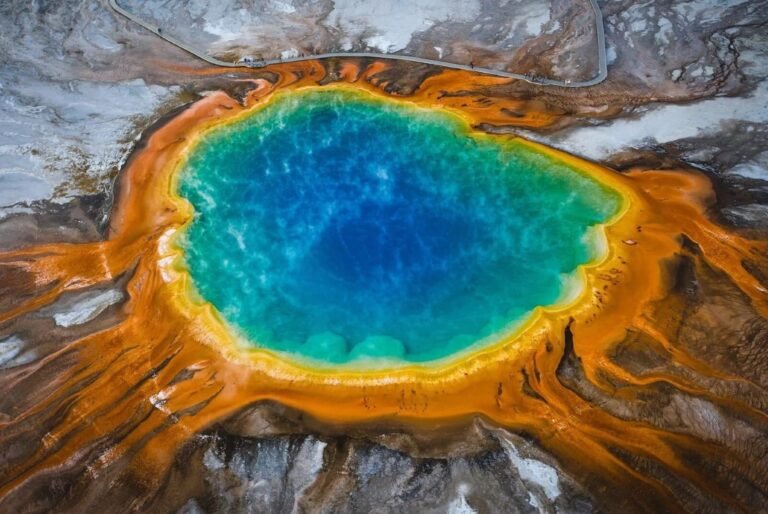Yellowstone National Park has long captivated scientists and the general public due to its geothermal activities and status as a dormant supervolcano. Recent seismic research studies have uncovered hidden magma chambers beneath Yellowstone, enhancing our understanding of the region’s geology. These findings have deepened ongoing questions about the potential eruption risks and consequences of the Yellowstone Volcano.
Radiating New Insights on Volcanic Activity at Yellowstone
Yellowstone sits atop one of the largest volcanic systems on Earth. Its past supervolcano eruptions have led to severe environmental changes.
However, the magma structures beneath the surface have remained a mystery. Thanks to advancements in seismic imaging technology, scientists have discovered hidden magma chambers beneath Yellowstone that lie far deeper than previously known.
- These new findings show that the magma system is more complex than we thought.
- Researchers from the University of Utah have mapped these chambers, offering a clearer view of the region’s geothermal dynamics.
The Role of Hidden Magma Chambers in Volcano Function
These hidden magma chambers beneath Yellowstone may significantly impact how magma flows within the volcanic system. By controlling magma movement, they add complexity to an already intricate process.
Implications of Discovering Hidden Magma Chambers Beneath Yellowstone
The discovery of more magma chambers Yellowstone’s surface dramatically changes our understanding of the volcano’s eruption potential. Previously, scientists believed there was just one large chamber beneath the park. Now, they know there are multiple chambers, each with its own role.
- Multiple magma chambers could alter how scientists assess eruption risks.
- Even without a looming eruption, these findings highlight Yellowstone’s volatile and evolving volcanic system.
Understanding the Interaction Between Magma Chambers
The newly uncovered magma chambers may interact in unpredictable ways, which could change how magma behaves and flow patterns. This means understanding the behavior of these chambers is key to predicting any future eruptions.
Is There a Risk of an Eruption at Yellowstone?
While these new discoveries are exciting, there’s no immediate eruption threat. Yellowstone’s eruption cycle is long, with the last major eruption occurring around 640,000 years ago. Scientists warn against assuming an eruption is imminent.
The U.S. Geological Survey (USGS) continues to monitor the volcano. They use seismographs, thermal imaging, and ground deformation measurements to track volcanic activity. So far, there’s no evidence suggesting an eruption is near. The current activity is mainly limited to geysers and hot springs, not an eruption.
The Long-Term Outlook for Yellowstone’s Volcanic Activity
Even though there’s no immediate eruption risk, the discovery of these hidden magma chambers will be a focus of future research. New monitoring tools will help experts better understand how the volcanic system works.
- Over the next few decades, scientists hope to gain more insight into how magma reservoirs function.
- This will improve predictions of volcanic activity and help protect both tourists and local communities.
Yellowstone’s Global Impact: A Wider Perspective
Yellowstone’s supervolcano is one of the most studied in the world due to its potential to disrupt not only the U.S. but the entire planet. An eruption could lead to global cooling, widespread crop failures, and massive ash fallout.
By understanding how magma flows and accumulates beneath Yellowstone, scientists can better prepare for the future. The knowledge gained from these hidden magma will help in managing monitoring systems, offering early warnings of possible escalation in volcanic activity.
Conclusion: The Ongoing Mystery of Yellowstone’s Hidden Magma Chambers
The discovery of hidden magma chambers beneath Yellowstone has revealed a far more complicated system than we initially thought. While an eruption isn’t imminent, the findings provide valuable insights into the forces shaping one of the most famous supervolcanoes on Earth. With ongoing monitoring and research, we may uncover more secrets beneath the surface, helping to predict and manage future risks.
- The exploration of these newly discovered magma chambers will allow scientists to better understand how they interact and how they could affect future eruptions.
- As research continues, scientists will be better equipped to predict and mitigate any volcanic activity, keeping Yellowstone and the world safe.
Yellowstone may be calm now, but the thrill of what lies beneath its surface continues to spark scientific curiosity.
